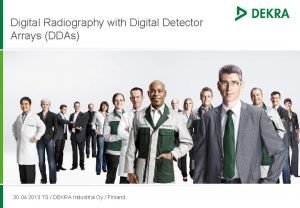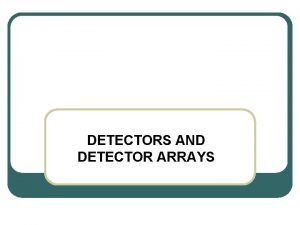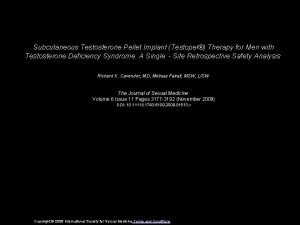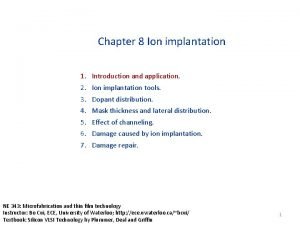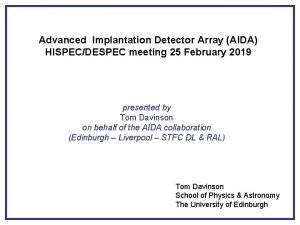AIDA introduction Advanced Implantation Detector Array AIDA UK



- Slides: 3

AIDA: introduction Advanced Implantation Detector Array (AIDA) UK collaboration: University of Edinburgh, University of Liverpool, STFC Daresbury Laboratory & STFC Rutherford Appleton Laboratory • Super. FRS • Exotic nuclei ~ 50 – 200 Me. V/u • Implant – decay correlations • Multi-Ge. V implantation events • Subsequent low-energy decays • Tag events for gamma and neutron detector arrays Detector: multi-plane Si DSSD array wafer thickness 1 mm 8 cm x 8 cm (128 x 128 strips) or 24 cm x 8 cm (384 x 128 strips) Instrumentation: ASIC low noise (<12 ke. V FWHM), low threshold (0. 25% FSR) 20 Ge. V FSR plus ( 20 Me. V FSR or 1 Ge. V FSR) fast overload recovery (~ms) spectroscopy performance time-stamping

AIDA: status • Systems integrated prototypes available - prototype tests in progress at STFC DL & University of Edinburgh Mezzanine: 4 x 16 channel ASICs Cu cover EMI/RFI/light screen cooling FEE width: 8 cm Prototype – air cooling Production – recirculating coolant FEE: 4 x 16 -bit ADC MUX readout (not visible) 8 x octal 50 MSPS 14 -bit ADCs Xilinx Virtex 5 FPGA Power. PC 40 x CPU core – Linux OS Gbit ethernet, clock, JTAG ports Power

AIDA: outlook • DSSSD with sub-contractor (MSL) • ASIC submitted for wafer production run (AMS) – delivery January 2011 • FEE mezzanine PCB – will be submitted for manufacture Nov 2010 – delivery January 2011 • FEE PCB with sub-contractor - delivery January 2011 • Mechanical design and infrastructure (HV, PSUs, cooling etc. ) - STFC DL & University of Liverpool arranging manufacture/purchase Production hardware will be available for integration/initial tests Feb/Mar 2011 AIDA expected to be ready for commissioning/first experiments from 2011/Q 3 - will require timestamping to be available
